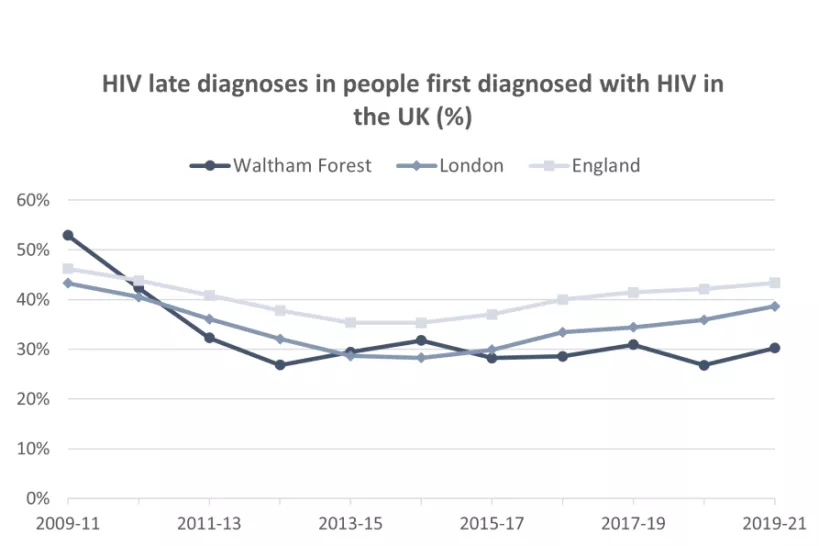Last updated: 15 August 2023
Next review: 20 June 2024
This content is part of the Waltham Forest JSNA. To see other JSNA content, visit the JSNA landing page
The rate of new HIV diagnoses had declined continuously due to a combination of testing, pre-exposure prophylaxis, rapid linkage to treatment and support for those diagnosed with HIV to attain viral suppression to prevent onward transmission [1]. In Waltham Forest, the new HIV diagnosis rate had fallen to 15.5 per 100,000 by 2019, down from 37 per 100,000 in 2012. The impact of the COVID-19 pandemic on services and patient access means that is difficult to interpret the changes in diagnosis rates observed between 2019 and 2021 [2].
The proportion of eligible attendees at specialist sexual health services who accepted a HIV test in Waltham Forest fell from 65.7% in 2019 to 52.0% in 2021. This is below the London average of 54.3%, but above the England average of 45.8%.
Despite a decline in the overall HIV diagnosis rate, a significant proportion of HIV cases are not identified until a late stage of infection. Diagnosis is considered late if a patient's level of CD4 cells (white blood cells) is below 350, which indicates that the infection has done significant damage to the patient's immune system. Those diagnosed late are at greater risk of ill-health and death compared to those diagnosed promptly. The HIV late diagnosis indicator includes people first diagnosed with HIV in the UK and excludes those previously diagnosed abroad. As such, this reflects how well undiagnosed late-stage infections are identified by HIV testing system in the UK and what portion of new diagnoses they constitute [3].
Waltham Forest has a lower rate of late HIV diagnosis (30.2%) compared to London and England (38.6% and 43.3% respectively). The late HIV diagnosis rate in Waltham Forest has stayed relatively stable in the recent years, whereas the rates for London and England have increased.

Source: OHID Public Health Outcomes Framework. Data from UK Health Security Agency (UKHSA). Date accessed: 25 April 2023.
References:
[1] Public Health England (2021). Health Profile for England 2021. Date accessed: 04 May 2023.
[2]UK Health Security Agency (2022). HIV testing, PrEP, new HIV diagnoses, and care outcomes for people accessing HIV services: 2022 report. Date accessed: 24 May 2023
[3] Office for Health Improvement & Disparities. Sexual and Reproductive Health Profiles. Data from UK Health Security Agency (UKHSA). Date accessed: 04 May 2023.